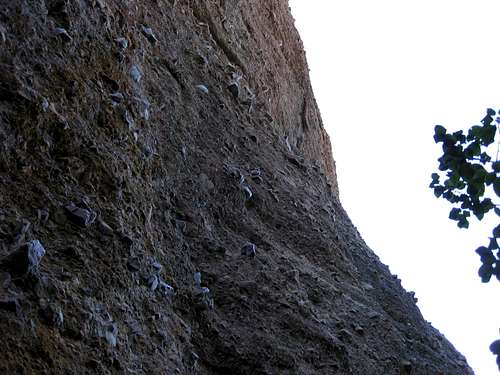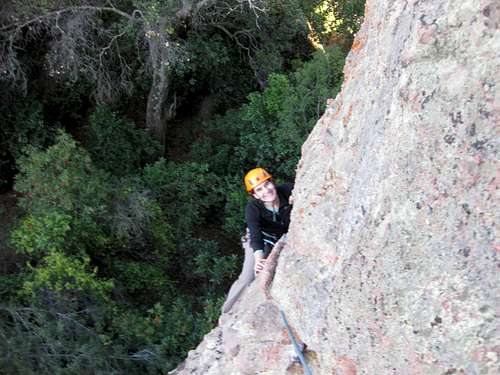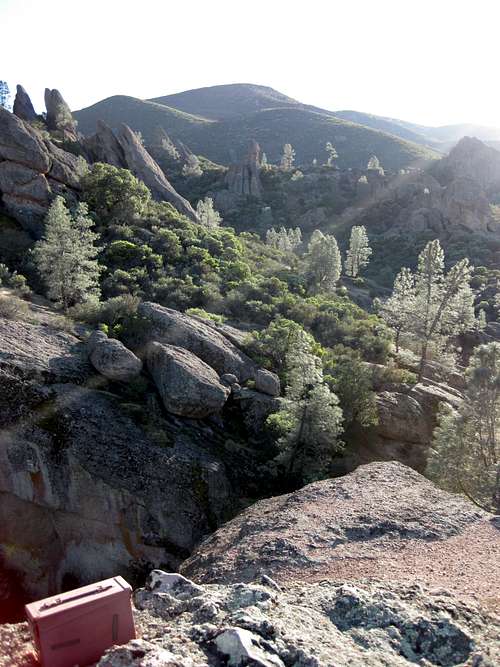|
|
Route |
|---|---|
|
|
Trad Climbing |
|
|
Spring, Fall, Winter |
|
|
Less than two hours |
|
|
5.8 (YDS) |
|
|
5.8 |
|
|
2 |
|
|
Overview
The Monolith is a popular formation for sport climbing, with routes from 5.5 to 5.14, but it also has a summit block with a register. The Regular Route is a Pinnacles classic, rated three stars in the guidebook.While the east face of the Monolith is about 80' high (not including the summit block), the Regular Route is typically climbed in two short pitches to prevent horrendous rope drag.
Getting There
The Monolith is most easily approached from the east side of the Monument. Park in the Bear Gulch lot, and start hiking from the Moses Spring trailhead. Take the first left, go up the Moses Spring trail and then through a tunnel. Turn right at the next junction, and then left. Do not take the trail towards the Bear Gulch Caves. There will be a 'Climber Access' sign not far afterwards. Turn right here, and take the use trail to the east face.
You can also get to the Monolith easily from the Discovery Wall: simply walk south along the wall, scramble down some boulders, and follow a trail to the next 'Climber Access' sign. Turn right here and take the use trail to the east face. If you make a wrong turn and see signs directing you to the Bear Gulch Caves, turn around and head back to the first junction after leaving the Discovery Wall (ask me how I know this :)
Once you get to the Monolith, pass some hard-looking 5.11's and 12's on the right. The route starts near a small tree or bush, perhaps 30' below a horizontal crack / roof. You should be able to see the first two bolts from the ground -- they actually look something like eyelets cemented into the rock.
Route Description
Pitch 1 (40-50', 5.8) : Start near the tree, heading up and right past the first two bolts.
Difficulties ease a bit and you will pass another bolt. Belay at a three-bolt anchor in kind of an alcove.

Pitch 2 (less than 40', 5.6-ish) : You will be looking up at an overhanging wall -- this is not where you want to go :) Hang a left, up easier terrain to a lower-angled slab, passing two bolts.

Soon you will be on the "summit plateau". There is a two-bolt anchor with rappel chains on the summit block.
The summit block is optional, but how can you come this far and not do it ? The top of The Monolith is flat, but loose so be careful not to knock rocks down on other parties. Walk around to the west side of the summit block and find easier terrain. There is a short roof / boulder problem to surmount (5.8 / V0-), and then you are on top.

There was an ammo box summit register when I did it, but the pages inside were all wet and nasty. Take in the views and then carefully downclimb, preferably with someone spotting you on the boulder move.
One single-rope rappel from the aforementioned rappel chains gets you back to terra firma.
Essential Gear
Three draws and anchor gear should do it. I have read that some people place cams on this route, so I brought them, but never used them.That said, this isn't really a sport climb -- the bolts are pretty sparse with the exception of the crux section.
Guidebooks
This route and others on the Monolith can be found in the following guidebooks :A Climber's Guide to Pinnacles National Monument, Brad Young, 2007.
California Road Trip - Northern California, Tom Slater, 2009.
History
FA John Whitmer, Craig Holden, 1955.According to Climber's Guide to Pinnacles National Monument, by David Rubine :
"The Monolith was originally summitted on February 17, 1935 by Dave and Ralph Brower, Bill Van Vorrhis, annd George Rockwood. The first ascensionists climbed the oak tree leaning over the right side of the east face and leaped across the abyss to join the Regular Route at its first belay. Climbing the tree is 5.7."

